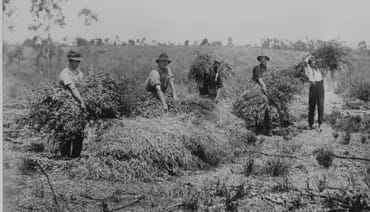Eucalyptus oil industry – present day operations

Harvesting the leaves
Originally, the blue and green mallee trees were cut down, leaving the stumps protruding from the ground. The timber was burned, then when the mallees re-sprouted to the required height, they were cut down by hand with a sickle. This was back-breaking work. The cutters also had to bend over to pick up the leaves to load them onto horse drawn wagons, and later wagons drawn by traction engines. Apparently, you could pick out the old eucy cutters around town by their permanent stoop.
When Kevin Jones introduced mechanical harvesting, all the stumps were cut off at ground level so as not to interfere with the operation of the harvester. Loading of the leaves was also mechanised. The leaves are now collected in bins which each hold about a tonne of leaves. In good conditions, 28 bins (i.e. 28 tonnes) of leaves will produce a 44 gallon drum of oil.

Oil production
The leaves are packed tightly into round brick-lined in-ground vats, then sealed with metal lids. About two tonnes of leaves can be packed into each vat. There are two vats at Parramatta Gully, and their dimensions are approximately two and a half metres in diameter and four metres in depth.
The use of in-ground vats was the traditional way to extract oil. Most existing eucalyptus oil distilleries have developed other methods e.g. truck mounted mobile vats. However, the Jones family distillery is unique in that it has stayed with the traditional method, increasing the heritage value of the site.
A boiler in the shed near the pits produces steam, which is forced into the bottom of the pits. Steam is pushed through the lower layers of the leaves so that they soften. More leaves can then be added so that the leaves can be more tightly packed.
After the metal lid has been closed, it is sealed off with clay to stop the steam escaping. Once it passes through the leaves, the steam is piped into a condenser. At Parramatta Gully, the condenser is in the form of a brick bath, to cool the steam and allow the oil to be extracted. As the process of distilling is nearing completion, the water/oil mix coming out of the condenser can be tested to see if there is any oil left in the leaves still in the pits.
The water must be replaced periodically to keep it cool. This water comes from the nearby dam. Past operators have been known to use the condenser as their own bath. Lovely warm water heated by steam – an opportunity too good to miss!
Recycling
Once the oil has been extracted, the leaves are removed from the pits. When dried out, they make excellent garden mulch, free from any contamination as they have effectively been sterilised. As a result, nothing from the process is wasted: everything is used or recycled.
Boiler
The current boiler is wood-fired. It is a 1954 English made Trevor Multi-tube boiler, which was acquired from the Scoresby Steam Museum when it was surplus to their needs. Jim Jones donated some money to the museum and arranged to transport the boiler to Rushworth. It is subject to regular inspections.
Dam
The Parramatta Gully dam dates back to 1892, when William Begg set up the first eucalyptus oil distillery on the site. Water from the dam is essential to be pumped into the boiler to be turned into steam and used in the condenser to cool the steam as it comes from the pits.
The dam fills from natural flows down Parramatta Gully. Below the dam, and across to the Whroo road, there is evidence of extensive alluvial gold mining from the mid-19th century.
References: A shout out to Jim and Karen Jones and their family for the above information, and for keeping this historic industry alive in the Rushworth area over many years.




